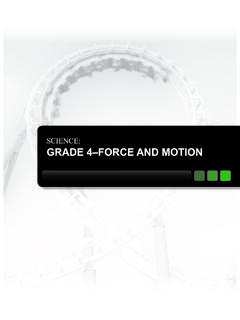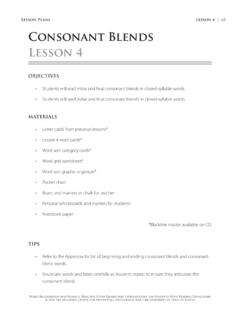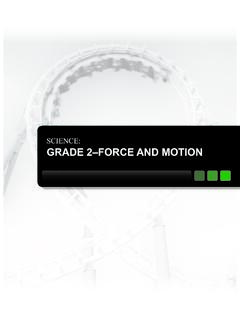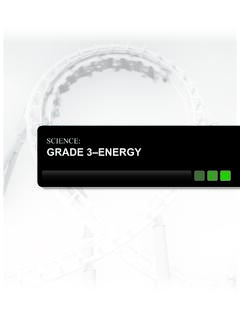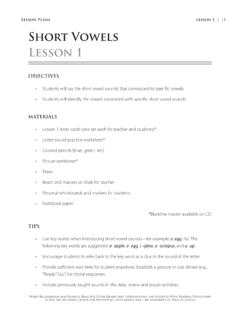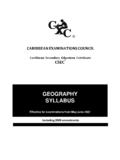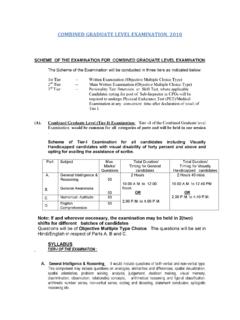Transcription of SCIENCE: GRADE 4–ENERGY
1 SCIENCE: GRADE 4 ENERGY232 GRADE 4 EnergyElectrifying EnergyTEKS4 (6) Force, motion, and energy. The student knows that energy exists in many forms and can be observed in cycles, patterns, and systems.(A) The student is expected to differentiate among forms of energy, including mechanical, sound, electrical, light, and heat/thermal.(B) The student is expected to differentiate between conductors and insulators.(C) The student is expected to demonstrate that electricity travels in a closed path, creating an electrical circuit ..** and explore an electromagnetic field not addressed by this lesson ScienceScience Process Skills4 (2) Scientific investigation and reasoning. The student uses scientific inquiry methods during laboratory and outdoor investigations.
2 (B) The student is expected to collect and record data by observing and measuring, using the metric system, and using descriptive words and numerals such as labeled drawing, writing, and concept (3) Scientific investigation and reasoning. The student uses critical thinking and scientific problem solving to make informed decisions.(C) The student is expected to represent the natural world using models such as rivers, stream tables, or fossils and identify their limitations, including accuracy and ObjectiveI can differentiate among forms of energy. I can also differentiate between conductors and insulators while demonstrating how an electrical circuit works. 2012 TEXAS EDUCATION AGENCY.
3 ALL RIGHTS 4 EnergyMathematics4 (16) Underlying processes and mathematical tools. The student uses logical reasoning.(A) The student is expected to make generalizations from patterns or sets of examples and Language Arts and Reading4 (11) Reading/ comprehension of informational text/expository text. Students analyze, make inferences and draw conclusions about expository text and provide evidence from text to support their understanding.(A) Students are expected to summarize the main idea and supporting details in text in ways that maintain meaning. (orally)4 (18) Writing/expository and procedural texts. Students write expository and procedural or work-related texts to communicate ideas and information to specific audiences for specific purposes.
4 (A) Students are expected to create brief compositions that:(ii) include supporting sentences with simple facts, details, and explanations.(B) Students are expected to write letters whose language is tailored to the audience and purpose ( , a thank you note to a friend) and that use appropriate conventions ( , date, salutation, closing).4 (27) Listening and speaking/listening. Students use comprehension skills to listen attentively to others in formal and informal settings. Students continue to apply earlier standards with greater complexity. (A) Students are expected to listen attentively to speakers, ask relevant questions, and make pertinent (28) Listening and speaking/speaking.
5 Students speak clearly and to the point, using the conventions of language. Students continue to apply earlier standards with greater complexity. Students are expected to express an opinion supported by accurate information, employing eye contact, speaking rate, volume, and enunciation, and the conventions of language to communicate ideas 4 EnergyEnglish Language Proficiency Standards1 (C) Cross-curricular second language acquisition/learning strategies. The student is expected to use strategic learning techniques such as concept mapping, drawing, memorizing, comparing, contrasting, and reviewing to acquire basic and GRADE -level vocabulary. Response to Intervention/Tier 1 DifferentiationAll science lessons support students in receiving quality Tier 1 instruction.
6 Using the 5E model, knowledge is taught in a variety of contexts, integrating math, science, and ELA content, thus supporting the active engagement of students with the content. Lesson-specific differentiation strategies for addressing diverse student needs can be found throughout each lesson in sections titled Differentiation Strategy. Language ObjectiveI can compare conductors and insulators using a (29) Listening and speaking/teamwork. Students work productively with others in teams. Students continue to apply earlier standards with greater complexity. Students are expected to participate in teacher- and student-led discussions by posing and answering questions with appropriate detail and by providing suggestions that build upon the ideas of 19.
7 Reading/ comprehension skills. Students use a flexible range of metacognitive reading skills in both assigned and independent reading to understand an author s message. Students will continue to apply earlier standards with greater depth in increasingly more complex texts as they become self-directed, critical readers. (C) The student is expected to monitor and adjust comprehension ( , using background knowledge, creating sensory images, re-reading a portion aloud, generating questions). (D) The student is expected to make inferences about text and use textual evidence to support understanding. 2012 TEXAS EDUCATION AGENCY. ALL RIGHTS 4 EnergyDifferentiation should focus on skills students did not understand and extend the lesson for advanced students; be conducted in small groups or embedded in whole-group instruction; and provide students with a variety of strategies to process the information, such as -allowing for additional opportunities for verbal brainstorming of words associated with a topic (with teacher taking dictation); -making clear connections of new and more complex concepts to foundational aspects and prior knowledge; -participating in more tangible experiences, such as experiments, investigations, and active exploration.
8 -sorting academic vocabulary words into categories by common attributes process words or science content vocabulary; -organizing brainstorming into semantic maps or creating graphic organizers; -discussing the meaning of a graphic organizer with a partner; and -creating a visual representation to demonstrate the handout in the Content Resources section that addresses instructional and Career Readiness Collaborative and safe working practices. Understand and apply safe procedures in the laboratory and field, including chemical, electrical, and fire safety and safe handling of live or preserved Use several modes of expression to describe or characterize natural patterns and phenomena.
9 These modes of expression include narrative, numerical , graphical, pictorial, symbolic, and Use essential vocabulary of the discipline being studied. Measurements and models. Use models to make 4 EnergyPrerequisite Science KnowledgeK (6)(A) The student is expected to use the five senses to explore different forms of energy such as light, heat, and (6)(A) The student is expected to identify and discuss how different forms of energy such as light, heat, and sound are important to everyday (6)(A) The student is expected to investigate the effects on an object by increasing or decreasing amounts of light, heat, and sound energy such as how the color of an object appears different in dimmer light or how heat melts (6)(A)
10 The student is expected to explore different forms of energy, including mechanical, light, sound, and heat/thermal in everyday Focusconductorelectrical circuitelectrical energyheat/thermal energyinsulatorlight energymechanical energysound energy 2012 TEXAS EDUCATION AGENCY. ALL RIGHTS 4 Energy5E Lesson SummaryEngage Students observe different forms of energy in an energy Students demonstrate that electrical energy travels in a closed Students explain how electricity flows through a circuit and how conductors and insulators interact with the Students investigate conductors and insulators in a Students write a letter explaining how to build a working 4 EnergyEngageTeacher NoteEnergy balls can be purchased from science suppliers or teacher supply Instruction Hold the energy ball for all students to observe.
